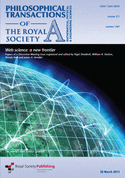In recently published article in Philosophical Transactions of the Royal Society, Hungarian physicist Albert-László Barabási discovered that any two pages on the internet are connected by 19 clicks or less.
 [Barabási] discovered that of the roughly 1 trillion web documents in existence—the aforementioned 14 billion-plus pages, along with every image, video or other file hosted on every single one of them—the vast majority are poorly connected, linked to perhaps just a few other pages or documents.
Distributed across the entire web, though, are a minority of pages—search engines, indexes and aggregators—that are very highly connected and can be used to move from area of the web to another. These nodes serve as the “Kevin Bacons” of the web, allowing users to navigate from most areas to most others in less than 19 clicks.
Barabási credits this “small world” of the web to human nature—the fact that we tend to group into communities, whether in real life or the virtual world. The pages of the web aren’t linked randomly, he says: They’re organized in an interconnected hierarchy of organizational themes, including region, country and subject area.
Interestingly, this means that no matter how large the web grows, the same interconnectedness will rule. Barabási analyzed the network looking at a variety of levels—examining anywhere from a tiny slice to the full 1 trillion documents—and found that regardless of scale, the same 19-click-or-less rule applied.
This arrangement, though, reveals cybersecurity risks. Barabási writes that knocking out a relatively small number of the crucial nodes that connect the web could isolate various pages and make it impossible to move from one to another. Of course, these vital nodes are among the most robustly protected parts of the web, but the findings still underline the significance of a few key pages.
Read the full article.
Buy a copy of Web science: a new frontier at Philosophical Transactions of the Royal Society.
[Barabási] discovered that of the roughly 1 trillion web documents in existence—the aforementioned 14 billion-plus pages, along with every image, video or other file hosted on every single one of them—the vast majority are poorly connected, linked to perhaps just a few other pages or documents.
Distributed across the entire web, though, are a minority of pages—search engines, indexes and aggregators—that are very highly connected and can be used to move from area of the web to another. These nodes serve as the “Kevin Bacons” of the web, allowing users to navigate from most areas to most others in less than 19 clicks.
Barabási credits this “small world” of the web to human nature—the fact that we tend to group into communities, whether in real life or the virtual world. The pages of the web aren’t linked randomly, he says: They’re organized in an interconnected hierarchy of organizational themes, including region, country and subject area.
Interestingly, this means that no matter how large the web grows, the same interconnectedness will rule. Barabási analyzed the network looking at a variety of levels—examining anywhere from a tiny slice to the full 1 trillion documents—and found that regardless of scale, the same 19-click-or-less rule applied.
This arrangement, though, reveals cybersecurity risks. Barabási writes that knocking out a relatively small number of the crucial nodes that connect the web could isolate various pages and make it impossible to move from one to another. Of course, these vital nodes are among the most robustly protected parts of the web, but the findings still underline the significance of a few key pages.
Read the full article.
Buy a copy of Web science: a new frontier at Philosophical Transactions of the Royal Society.
Keywords: Albert-László Barabási • Interconnectedness